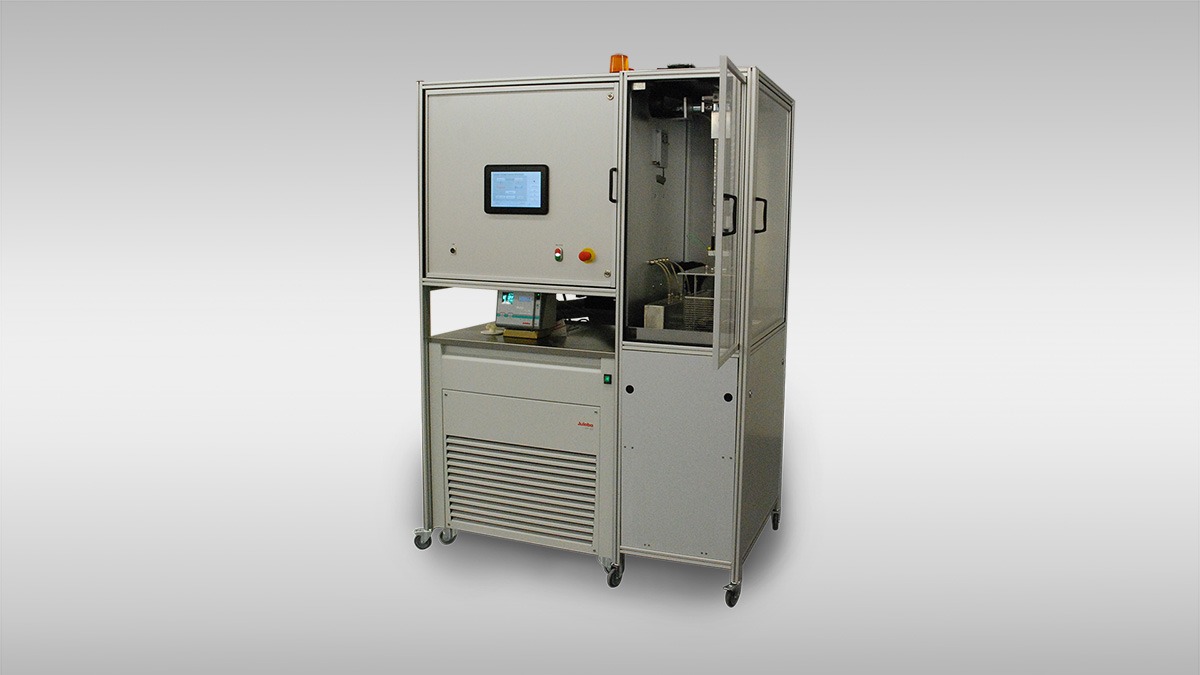Liquid-To-Liquid Thermal Shock
Use the liquid-to-liquid thermal shock test method to test the resilience of your products under fluctuating temperature conditions. We offer you a fully comprehensive test bench package.
Your reliable partner for life cycle simulation
Are you familiar with this? You are in the middle of developing your products. The challenge: The product is used under highly fluctuating temperature conditions. It is therefore extremely important to test the resilience of the product ahead of time. A suitable method for this is the liquid-to-liquid thermal shock test. This allows you to make valid conclusions about the load-bearing capacity of your product. With the test bench, you can simulate accelerated aging at temperatures ranging from -40 °C to +100 °C. With the automated liquid shock tester, product validations under extreme environmental conditions are possible. Use the results to increase the resilience of your products!
As a competent partner, …
- we are passionate about our products and want you to get the most out of them.
- we also adapt our products specifically to your requirements.
- we focus on consulting and service: cost optimization, quality optimization, on-site planning support.
Liquid-To-Liquid Thermal Shock - FAQ's
What is a Liquid-To-Liquid thermal shock Test?
A liquid shock test, also called a liquid-to-liquid thermal shock test, is about testing a DUT for demanding environmental conditions. There are applications where extreme temperature differences play a role. For the industry it is interesting to make a valid statement for the lifetime of a product. If the product is exposed to changing temperatures, this must be simulated. Of course, manufacturers want to make a statement as quickly as possible. For this purpose, the product is tested under extreme conditions. The advantage is that the test phase is shorter. The results are then scaled to the life cycle of the product.
You can also analyze and evaluate the resilience of products when used in consistently high temperatures with the burn-in oven.
What is tested with a liquid shock test?
For example, encapsulated electronics, a control unit, etc. are tested. After being subjected to several test cycles, the test samples are usually examined. For example, the relevant question is: Are the electronics still functioning, have cracks occurred, is the sealing effect still given, etc.?
What factors do I need to take into account during the shock test?
There are basically 3 different factors that affect the strength of a shock test:
Factor 1: The shortness of the time in which the temperature change occurs. The shorter the duration of the temperature change, the greater the shock effect.
Factor 2: The magnitude of the temperature difference. Here, care must be taken not to scale too high. Otherwise there would be the danger of creating other effects. For example, structures could be irrevocably destroyed just by reaching a temperature threshold once.
Factor 3: The heat capacity of the medium in which the shock takes place. The most common type of shock test uses the differences between cold air and warm air. However, there are liquids with far greater heat capacity. A liquid to liquid shock test has a greater shocking effect compared to an air to air system.
How does the liquid-to-liquid thermal shock tester work?
The Liquid-to-Liquid Thermal Shock Chamber consists of two thermally insulated baths. These can be heated to temperatures down to -40°C and up to +100°C respectively. Each contains the same liquid medium. The test samples can be placed in a basket, which is then transported between the two baths.
To ensure the safety of the employees, the access doors are secured. During the test, no one can interfere with the test room. The tester is controlled via a touch control panel. Users, profiles, etc. can be created there.
Which liquid medium is used in the shock test?
Thermal H5 from the Julabo company is currently used as a liquid medium for the liquid shock test. This is a silicone oil.
Is the liquid medium harmful to health?
According to the manufacturer, the composition of the liquid medium does not pose a health hazard. The danger comes primarily from high and low temperatures of the medium. Due to this, it is prescribed to carry out work in the interior exclusively with oil- and heat-resistant gloves on.


